Sternberg Press
Sternberg Press

The Disintegration of a Critic
Thirty texts by cultural critic, auto/biographer, and lesbian icon Jill Johnston.
Jill Johnston was renowned as a writer on dance, especially on the developments around Judson Dance and the 1960s downtown New York City scene, and later as the author of the radical-feminist classic Lesbian Nation (1973). This book collects thirty texts by Jill Johnston that were initially published in her weekly column for The Village Voice between 1960 and 1974. The column provided a format in which Johnston could dissolve distinctions between the personal, the critical, and the political. Her writing took turns and loops, reflecting its times and contexts, and set a stage for the emergence of Johnston as a public figure and self-proclaimed radical lesbian that defied any prescribed position.
Johnston's original texts are accompanied by three new contributions by Ingrid Nyeboe, Bruce Hainley, and Jennifer Krasinski, as well as an appendix with archival material related to a panel Johnston organized in 1969, titled “The Disintegration of a Critic: An Analysis of Jill Johnston.”
Edited by Fiona McGovern, Megan Francis Sullivan, Axel Wieder.
Texts by Jill Johnston; contributions by Bruce Hainley, Jennifer Krasinski, Ingrid Nyeboe.

Alternative Pedagogical Spaces – From Utopia to Institutionalization
A critical exploration of the values and qualities inherent in independent educational organizations and the hurdles in the way of remaining "alternative" with the passing of time.
Grounded in empirical research, Alternative Pedagogical Spaces: From Utopia to Institutionalization is a critical inquiry into the establishment, development, and transformation of alternative pedagogical and social spaces. Written by Anna Colin, a former director and co-founder of Open School East, an independent art school and community space founded in London in 2013, this essay-length book explores the instituting factors, organizational life cycles, and alignments and misalignments between values and practices that permeate such a project. The essay delves into the qualities and prerequisites for what Colin calls "multi-public educational organizations." It also scrutinizes the hurdles associated with the effort to remain alternative, including processes of habituation, temptation or pressure to scale up, ethos-bending fundraising exercises, and long tenure, as well as the plain desire for stability and sustainability.
Alternative Pedagogical Spaces proposes where to look for a reconceptualization of waiting, slowness, and longevity, and asks how these ideas may benefit cultural practice and the design of future institutions (or the redesign of existing ones). Overriding the common assumption that success equals longevity, the author searches for institutional models that resist chrononormativity, drawing from social movements, psychotherapy, biology, and permaculture.

Writings and Interviews
The collected writings of artist Marc Camille Chaimowicz, along with the stories behind them told by Alexis Vaillant.
Marc Camille Chaimowicz was an acclaimed visual artist known for his performances, installations and curatorial flair. He was also a writer. This volume, the first comprehensive collection of writings by the artist, includes seminal interviews, chitchats, jokes, performance reports, insightful statements and letters in essay form, as well as rare documents, such as early surviving leaflets, typewriter handouts and hard-to-find articles. Spanning 1971–2023, the book unlocks the work of an artist considered to be a refreshing role model for a new generation of culture mavens and style savants.
Drawing from literature, modernist architecture, interior design, art theory, glam rock and camp culture, the collection reveals the artist's inner self alongside the art, social flânerie and the goings-on of his time. Entertaining and witty, the texts stand out brilliantly with their early acumen and inclusivity, while setting a new template for an expression of queerness through writing. With access to Chaimowicz's personal material and photographs, curator and editor Alexis Vaillant is a guide to the artist's writings. Vaillant provides behind-the-scenes commentary and context—a time capsule of pleasure featuring Andy Warhol, Des Esseintes, Josef Frank, David Bowie, Vito Acconci, Eileen Gray, Alex Kapranos, Jean Cocteau, Elsa Schiaparelli, Jean Genet, Bob Dylan, Emma Bovary and Roger Cook, among others.
Edited by Alexis Vaillant.
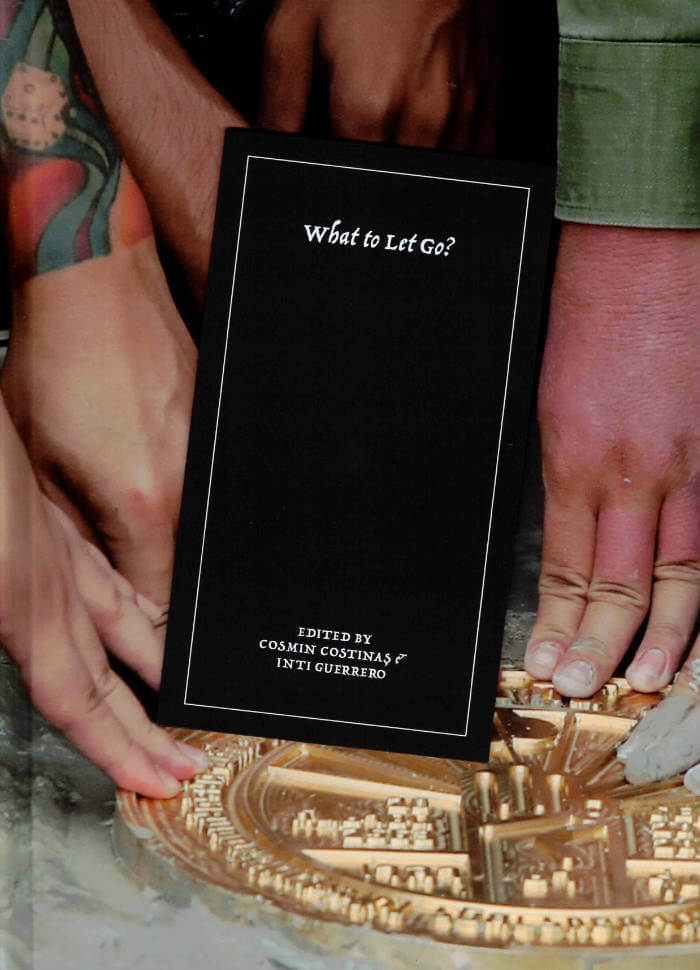
What to let go?
Cosmin Costinaş, Inti Guerrero
What gets counted within the category of heritage, and who gets to do the counting?
This book contributes to discussions about what counts as heritage now, who gets to do the counting, and broader related issues around the subject of cultural sovereignty. It unpacks historical narratives and political memories linked with objects, sites, and ceremonies that have been lost, looted, restituted, repatriated, revived, or reinvented. Through its diverse line-up of discourse, poetry, and original artistic contributions, it weaves together subjects and geographies that are not usually part of the same conversation —from plundered cultural belongings held in colonial collections, to processes of renaming or removing symbols of past eras— and considers how they relate in the context of recent social upheavals and political processes across continents.
In our era of dangerous revisionism, when history has become a battlefield for both the left and the right, we are asking: How can art reconfigure our collective foundational myths? And of what should we let go on the journey towards figuring it out?
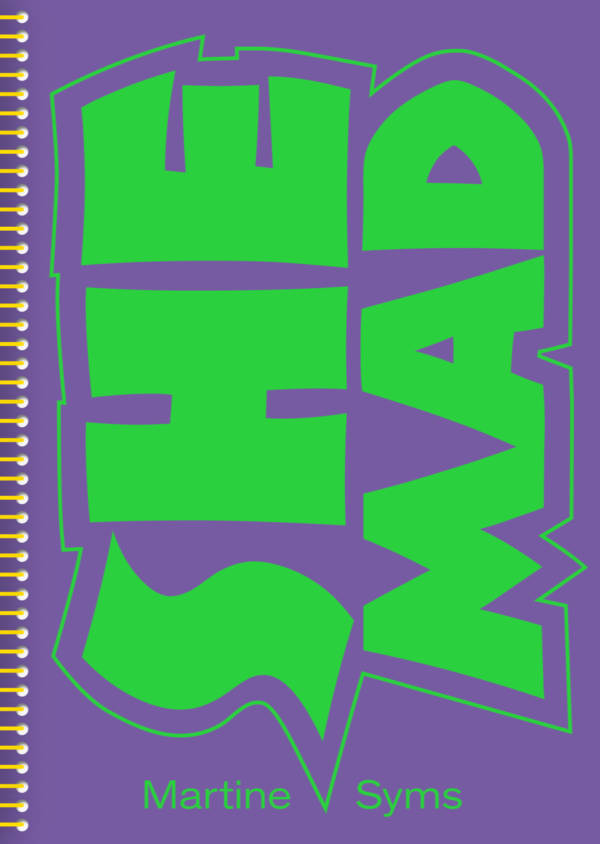
She Mad
She Mad gathers materials and documentation on Martine Syms' seminal episodic project of the same name. Each episode of this series takes a different format, using various narrative formats, from sitcoms to TikTok videos, and includes filmed footage as well as research materials. Each episode revolves around a protagonist, also named Martine—an overachieving, stoner graphic designer who lives in Hollywood and wishes she were an important artist.
The first episode Pilot for a Show about Nowhere (2015) merges a semi-autobiographical account of Syms' own life as a young black woman with a video essay-like narrative on the history of commercial television and its assumed target audiences. The episode Laughing Gas (2016) draws on early cinema, specifically the 1907 silent film of the same name by Edwin Porter, one of the earliest examples of a black female actress, Bertha Regustus, performing an independent role on-screen. Intro to Threat Modeling (2017) is told through email exchanges, screengrabs, and an avatar, outlining the effects of surveillance on subjectivity. The episode Bitch Zone (2020) takes us to an empowerment programme for teenage girls founded by supermodel and business mogul Tyra Banks.
Published on the occasion of the exhibition She Mad – Season One at Bergen Kunsthall, Norway and the Museum of Contemporary Art, Chicago, USA.
Martine Syms (born 1988 in Los Angeles) is an American interdisciplinary artist who has earned wide recognition for a practice that combines conceptual grit, humor, and social commentary. Her works explore how mass media shapes and frames identities and cultures. Drawing from early cinema, television, the internet, social media, and ambient footage produced by phones and surveillance, Syms addresses the ways in which representations of black identity and gender appear in the public imagination.
Edited by Axel Wieder.
Texts by Jadine Collingwood, William Pym, Axel Wieder.
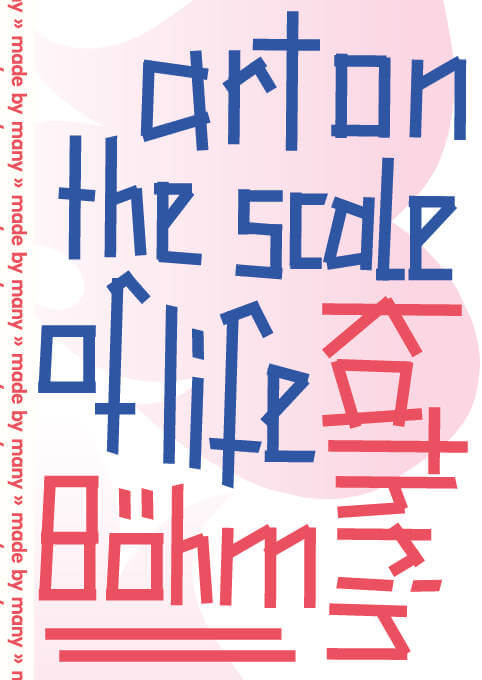
Art on the Scale of Life
A comprehensive overview of artist Kathrin Böhm's multifaceted, deeply collaborative, and durational practice and networks.
This volume critically profiles, contextualizes, and theoretically elaborates the unique practice of the UK-based German artist Kathrin Böhm. Combining visual and textual material, it offers an overview of Böhm's exceptional modus operandi that is rooted in a highly original artistic synthesis of a range of practices. Over the last three decades, Böhm has expanded the terms of socially engaged ways of working to an unprecedented scale and breadth by producing complex organizational, spatial, visual, and economic forms. These often entail the production of complex infrastructures, manifested via projects such as Culture is a Verb (2018–21), The Centre for Plausible Economies (2018–ongoing), Company: Movements, Deals and Drinks (2014–ongoing) and the Eco-Nomadic School (2010–ongoing). The book follows a major mid-career exhibition at The Showroom, London, in 2021.
Offering a significant addition to debates on contemporary art and architecture, social action, and public culture, Kathrin Böhm: Art on the Scale of Life brings together critical reflections by internationally acclaimed contributors. Spanning a wide range of critical positions and disciplines, these include Dave Beech, Céline Condorelli, Elvira Dyangani Ose, Wapke Feenstra, Katherine Gibson, Joon-Lynn Goh, Lily Hall, Yolande Zola Zoli van der Heide, Grace Ndiritu, Gerrie van Noord, Paul O'Neill, Doina Petrescu, Gregory Sholette and THEMM!!, Kuba Szreder, Gavin Wade, Mick Wilson, Stephen Wright, and Franciska Zólyom. In addition, material derived from Böhm's international networks and projects provides an in-depth impression of the deeply ingrained collaborative and durational nature of her way of working.
Photographic, diagrammatic, and typographical imagery runs through the book, demonstrating the rich visual and spatial languages embedded in Böhm's work. This visual register of the book is therefore much more than a series of illustrations and acts as a counterpoint to, and extension of, the ideas elaborated in the texts.
Kathrin Böhm is an international artist based in London. Her work takes place in and outside the art world, as she engages with governance, economics and different trans-local communities. Her main interests are the collective (re-)production of public space, trade as public realm and the everyday as a starting point for culture.
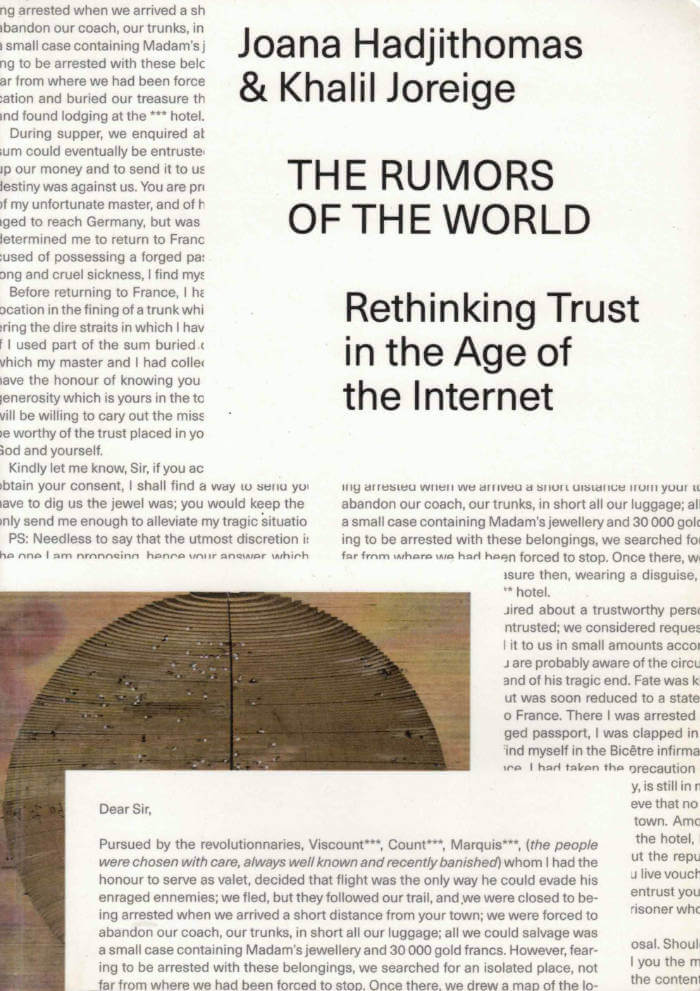
The Rumors of the World – Rethinking Trust in the Age of the Internet
Khalil Joreige, Joana Hadjithomas
This book traces the work and research of filmmakers and visual artists Joana Hadjithomas and Khalil Joreige and their exploration through their work of online spam e-mails, specifically, advance-fee frauds and scam messages.
This monograph presents material collected by the artists since 1999, focusing on the way that personal narratives are formed and articulated in a post-digital age. This work functions as a starting point for a broader discussion by leading scholars and thinkers on the nature of power and trust in the age of the Internet. Underlying this is an interrogation of faith: How has trust been recomposed by the Internet, and equally, how does the traditional practice of faith question the way that individuals relate to each other online?
Since the mid-1990s, Lebanese artists Joana Hadjithomas & Khalil Joreige (b. 1969, live and work in Beirut, Lebanon, and Paris) have worked together in the visual arts and cinema–shooting documentaries and fictions such as "I Want To See," starring Catherine Deneuve and Rabih Mroué and screened at the Cannes Festival in 2008.
Their practice in both fields is imbued with a distinctive aesthetic that occupies spheres of the visible and the fictional, nourishing a fascinating back and forth between life and fiction. Investigative processes, excavation, and the representations of historic, social, cultural, and political factors are at the heart of their practice. In their words: "All our work exists on the frontier of a reality where the question of the territory and its delimitation (that of art, that of personal life), the question of the social body and the individual body, are constantly being posed."
Their films have been multi awarded in international festivals and enjoyed releases in many countries. Their artworks have been shown in museums, biennials and art centers around the world, in solo or collective exhibitions and are part of important public and private collections, such as Musée d'Art Moderne de la Ville de Paris; Guggenheim, New York; Centre Georges Pompidou, France; V & A London, Sharjah Art Foundation, UAE, etc.
Edited by Omar Kholeif.
Contributions by Nicholas Auray, Finn Brunton, Joana Hadjithomas & Khalil Joreige, Henriette Huldisch, Omar Kholeif, Norman M. Klein, Eric Mangion, Laura U. Marks, Franck Leibovici, Sarah Perks, Jacques Rancière, Uzma Rizvi, Rasha Salti.

Citizens of the Cosmos
This book on the films of Anton Vidokle features essays and conversations by theorists, curators, and artists exploring the themes of technological immortality and resurrection informed by Cosmist philosophy.
Citizens of the Cosmos examines the artist Anton Vidokle's films and the Cosmist philosophy underpinning them. It features essays and conversations with Vidokle by seminal contemporary theorists, curators, and artists: Franco "Bifo" Berardi, Keti Chukhrov, Liam Gillick, Boris Groys, Daniel Muzyczuk, Miguel Amado and Georgia Perkins, Elizabeth Povinelli, and Raqs Media Collective. This is the first book to survey Vidokle's Cosmism-related filmic output, begun in 2014, and includes full scripts from the films.
The book's contributors speculate on Vidokle's Cosmist conceptions of technological immortality, utopian resurrection, museology, and space travel, grappling with how these ideas embroil or crystallize contemporary theories, practices, and technologies: atmospheric manipulation, cryonics, biopolitics, extraplanetary prospecting, geo-engineering, transhumanism, genetics.
Franco "Bifo" Berardi disagrees with the Cosmist conjecture of death as a flaw in the conception of the human being. Elizabeth Povinelli digests the life-nonlife mattering of dust through relationships to and from the human and more-than-human ancestors to come.
Boris Groys contemplates the gravitational forces between Cosmism and communism according to cosmic and social orders, grounded as they are in the laws of both physics and socialist politics. Keti Chukhrov considers the formation of thinking through madness, dying, and reasoning according to Cosmist philosophical and religious debates and beliefs.
Raqs Media Collective and Anton Vidokle discuss different cultures of death, finitude, and rituals. Miguel Amado and Georgia Perkins examine the in-betweeness of the categories of life and death through the designs of terraforming vehicles navigating interplanetary space travel.
Daniel Muzyczuk investigates Vidokle's interests in the context of the history of the collection at the Muzeum Sztuki in Łódź, while Liam Gillick and Anton Vidokle converse about filmmaking references and methods, from voiceover narrative to editing processes.
Edited by Miguel Amado. Contributions by Franco "Bifo" Berardi, Keti Chukhrov, Raqs Media Collective, Liam Gillick, Boris Groys, Daniel Muzyczuk, Miguel Amado and Georgia Perkins, Elizabeth A. Povinelli.

Raven Chacon: A Worm’s Eye View From a Bird’s Beak
Stefanie Hessler, Katya García-Antón and 1 more
A career-spanning catalogue featuring excerpts from Raven Chacon’s scores, musical prompts, and drawings interspersed with full-color documentation and descriptive texts of installations, sculptures, and performances. Raven Chacon is a composer and artist creating musical experiences that explore relationships among land, space, and people.
In an experimental practice that cuts across the boundaries of visual art, performance, and music, Chacon breaks open musical traditions and activates spaces of performance where the histories of the lands the United States has encroached upon can be contemplated, questioned, and reimagined. In 2022, Raven Chacon became the first Native American to win the Pulitzer Prize for Music, and was awarded a prestigious MacArthur “genius” fellowship in 2023.
Texts by Raven Chacon, Lou Cornum, Aruna D'Souza, Candice Hopkins, Anthony Huberman, Ingir Bål Nango, Marja Bål Nango, Dylan Robinson & Patrick Nickleson, Eric-Paul Riege, Sigbjørn Skåden, Ánde Somby.
Foreword by Katya García-Antón and Stefanie Hessler.

A Rage in Harlem – June Jordan and Architecture
Pennsylvania State Senator Nikil Saval tells the story of an unlikely partnership between June Jordan and R. Buckminster Fuller, and their attempt to reimagine Harlem in the wake of the 1964 riots.
In the tense days leading up to the 2020 American elections, design critic and then-candidate for Pennsylvania State Senate Nikil Saval addressed a virtual audience at the Harvard GSD to tell a story about Black feminist writer June Jordan and a little-known project that resulted from the aftermath of the 1964 Harlem riot. The events of police brutality and community grieving made a lasting impression on Jordan, who, while known for her work as a poet, playwright, and activist, responded with a proposal for a multiple-tower housing design. Through an unlikely partnership with R. Buckminster Fuller, Jordan's "Skyrise for Harlem" project offered a Futuristic vision for Harlem that argued for environmental redesign: "it is architecture, conceived of in its fullest meaning as the creation of environment, which may actually determine the pace, pattern, and quality of living experience." Jordan was not an architect in the conventional sense, Saval says. "But in the understanding of someone who sought to propose and build interventions in public space, she was."
Nikil Saval (born 1982) is an Indian-American magazine editor, writer, organizer, activist, and politician, member of the Democratic Party.
Foreword by Sarah M. Whiting.
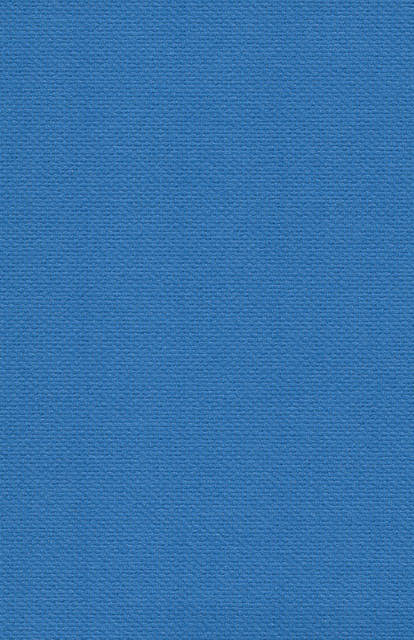
yksihW kcalB
The 15-year history of the production of a "German scotch" Black Whisky, made by Dexter Sinister together with Stahlemühle, a distillery set up by former publisher, Christoph Keller.
The story is told in reverse, starting with the delivery of 342 bottles to Berlin in 2022, and ending with an interview with Christoph for the journal Dot Dot Dot in 2007, during which the idea began to germinate. A summary of the project is accompanied by photographs taken at the time, interspersed with five previously published texts (an essay, three conversations, and a statement of intent) written along the way.
Dexter Sinister is the compound name of David Reinfurt and Stuart Bailey, collapsing together distinctions of editing, design, production and distribution into one efficient activity.

Burn & Gloom! Glow & Moon!
Retrospective monograph: a journey through over two decades of intersectional and queering practices in film, performance, sculpture, community work, and textiles.
In Daschner's textile-based works, threads are minimal yet highly visible, akin to the pinch needed to wake up from a dream. These works—as well as her collages—merge with her confronting yet inviting image politics: she cuts and pastes stories of love and pleasure, violence and resilience, death and rebirth.
The written contributions reflect on Katrina Daschner as part of a hardworking generation of queer artists and makers who have been responding to the major conceptual shifts and gender upheavals happening in contemporary art since the 1990s, especially in New York and London. They highlight Katrina Daschner's longstanding line of intersectional queer interest that continues to undermine (neo-)liberal, heteropatriarchal conceptions of sexuality, gender, subjectivity, and relationships
Edited by Övül Ö. Durmuşoğlu.
Texts by Amelia Groom, Tim Stüttgen; foreword by Övül Ö. Durmuşoğlu; interviews by Rike Frank.

On the Table 6 – The Meal – A Conversation with Gilbert & George
Gilbert & George, Charlotte Birnbaum
Charlotte Birnbaum meets with Gilbert & George to discuss The Meal—a culinary performance organized in 1969 by the British duo, with David Hockney as the guest of honor. Also included here are photos and memorabilia from the singular event (the sixth publication in the On the Table series, that explore the encounter between food and art).
Gilbert & George never cook and always eat out. Back in 1969, however, the artist duo hosted The Meal, an elaborate dinner party that included thirteen guests, Princess Margaret's butler, a chef who prepared a meal from a Victorian cookery manual, and the guest of honor, artist David Hockney. While the art world of the time was largely characterized by Pop art, Minimalism, and Conceptual art, Gilbert & George developed an entirely unique philosophy and combined their daily lives with their artistic vision; in short, their art and life are one! Charlotte Birnbaum took a trip to London's East End to visit the immaculately dressed pair to discuss The Meal and other curious projects from their fifty-year collaboration. Also included here are photos and memorabilia from the singular event.

Feminist Takes – “Early Works” by Želimir Žilnik
The prospects of revolutionary feminism, from Želimir Žilnik's canonical film.
Canonical within the Yugoslav New Film of the late 1960s and the 1970s, Želimir Žilnik's Early Works (1968) follows the female revolutionary Jugoslava as she leaves her lumpenproletariat family to spread the teachings of young Marx and Engels among the peasants and factory workers. The violent responses to this proselytizing mission, which include the rape of Jugoslava and the beating of her three male comrades, invoke the repression of the 1968 student movement in socialist Yugoslavia. The film's allegorical examination of the contradictions of Yugoslav state socialism culminates when Jugoslava becomes the object of her comrades' violence, who shoot her and set her body on fire.
This edited volume, a part of Antonia Majaca's ongoing collaborative investigation Feminist Takes, initiates a discussion of the filmic—and historical—fate of Jugoslava and the prospects of revolutionary feminism.
From his beginnings in the lively amateur film scene of Yugoslavia in the 1960s, filmmaker Želimir Žilnik (born 1942, based in Novi Sad, Serbia) has gone on to make more than fifty films, including a number of feature films and TV productions, often in the genre of docudrama. He received international recognition early on, winning the Golden Bear for Best Film at the 1969 Berlin International Film Festival for Early Works. In the 1970s his films encountered political opposition, and he left Yugoslavia for West Germany, where he realized several independent films, including some of the earliest films dealing with the topic of guest workers. In the 1980s, after leaving Germany—due to his films once again facing political opposition and censorship—and returning to Yugoslavia, he made numerous TV and feature films through which he portrayed early symptoms of the country's growing social conflicts, continuing in the 1990s with films dealing with the maladies of the post-socialist transition as well as questions of migration.
Edited by Antonia Majaca, Rachel O'Reilly, Jelena Vesić.
Texts by Ivana Bago, Angela Dimitrakaki, Branislav Dimitrijević, Irmgard Emmelhainz, Rose-Anne Gush, Vesna Kesić, Vedrana Madžar, Antonia Majaca, Jaleh Mansoor, Ruth Noack, Bojana Pejić, Ana Teixeira Pinto, Rasha Salti, Kerstin Stakemeier, Jelena Vesić, Giovanna Zapperi.

Bad Infinity – Selected Writings
The most significant critical, theoretical, and art historical texts by the artist, writer, and filmmaker Aria Dean.
Compiled here for the first time, the selected writings of Aria Dean mount a trenchant critique of representational systems. A visual artist and filmmaker, Dean has also emerged as one of the leading critical voices of her generation, through a body of writing that maps the forces of aesthetic theory, image regimes, and visibility onto questions of race and power. Dean's work across media has long been defined by what she calls a "fixation on the subject and its borders," and the texts collected here filter that inquiry through digital networks, art history, and Black radical thought. Equally at home discussing artists who embrace difficulty—from Robert Morris to David Hammons, Lorna Simpson, and Ulysses Jenkins—and conceptual frameworks such as Afropessimism, Dean often contends with how theoretical positions brush against the grain of lived reality: how the Structuralism handed down from the academy, for instance, can be co-mingled with critiques of structural racism, or how Georges Bataille's notion of base matter transforms through an encounter with Blackness.
Dean's thinking embraces a definition of "Black art that luxuriates in its outside-the-world-ness," as she writes in this volume, which works to elucidate "Blackness's proclivity for making and unmaking its own rules as it produces objects" of cultural necessity. Originally published in November as well as in Texte zur Kunst, e-flux journal, and in exhibition contexts, the essays compiled in Bad Infinity were written over a six-year span that charts our rapidly evolving forms of subjectivity and sociality.
Aria Dean (born 1993 in Los Angeles ) is an American artist, critic, writer and curator. Her writings have appeared in various art publications including November (of which she is a founding editor), Texte zur Kunst, Artforum, e-flux, The New Inquiry, Art in America, Topical Cream, Cura., Mousse, Flash Art, Spike, etc.
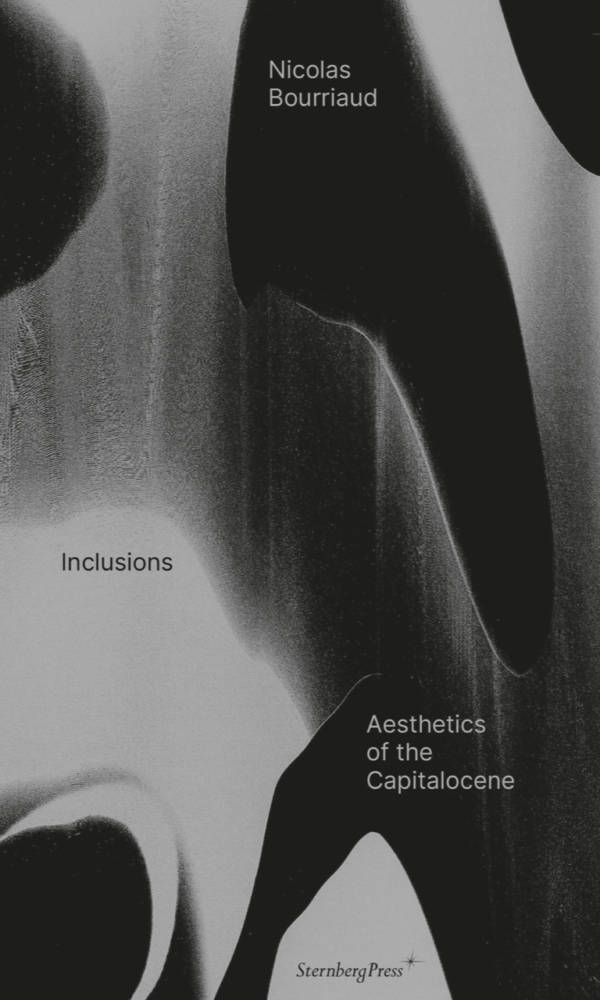
Inclusions: Aesthetics of the Capitalocene
The current ecological crisis brings about a new relational landscape: an unprecedented collapse of distances creates interspecies promiscuities and a crisis of the human scale. In Inclusions, Nicolas Bourriaud proposes that artists are the anthropologists of this new era.
"Today, the ecological catastrophe challenges us to rethink the space our societies have assigned to art. Creativity, critical thinking, exchange, transcendence, the relationship to the Other and to History are values intrinsic to artistic practice that will soon be of vital importance for the future of mankind. We need art to give a meaning to our lives, and the banks will not supply that. By attempting to unfold a few of the aesthetic figures floating in the global imaginary, this book intends to describe what is at stake in artistic activity in the age of the Capitalocene and to argue for it as a vital need."
Nicolas Bourriaud (born 1965) is a French curator, theoritian and writer.
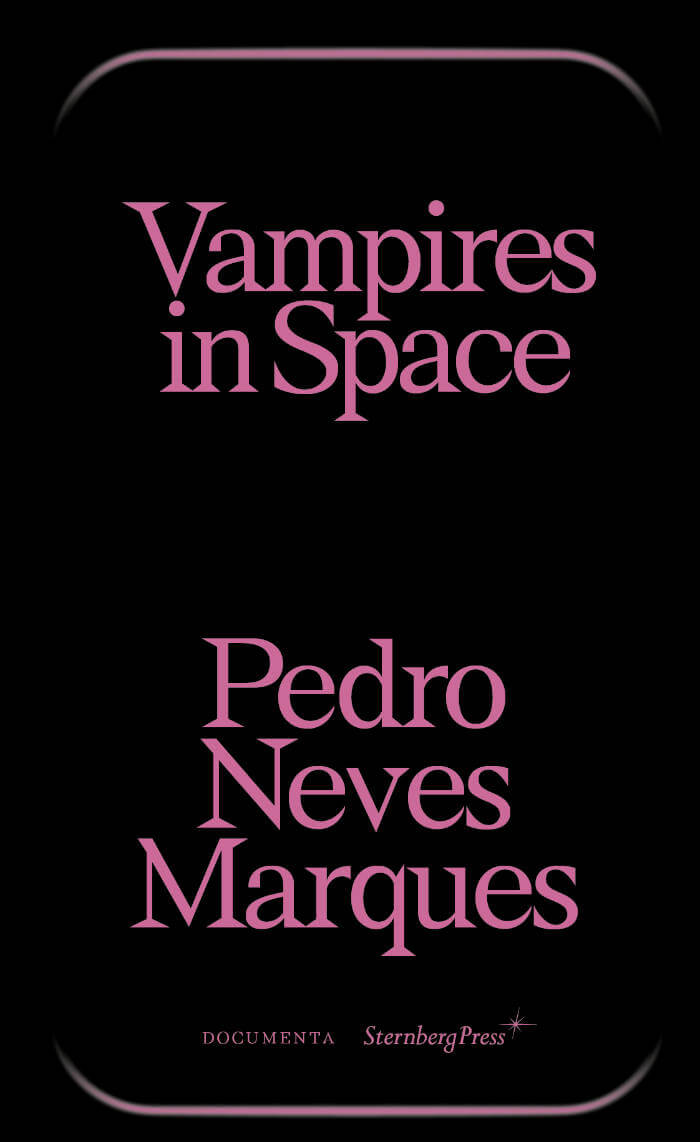
Vampires in Space
Exhibition catalogue of filmmaker, visual artist, and writer Pedro Neves Marques's solo project "Vampires in Space" at the Portuguese Pavilion, 59th International Art Exhibition – La Biennale di Venezia 2022.
"In space it's always night." A family of vampires travels through space, carrying life to a faraway planet. Alone, they recall their past, offering an open-ended narrative about the role of fiction in our lives, with a special care for transgender experiences.
This book includes an interview, film scripts and poetry by Neves Marques, curatorial texts by João Mourão, Luís Silva, alongside visual documentation and other contributions by Manuela Moscoso and Filipa Ramos.
The work of Pedro Neves Marques (born 1984 in Lisbon, Portugal) combines anthropological research, cinema, publishing, poetic and fictional writing. Their hybrid aesthetic, that blends science fiction and documentary realism is influenced by the history of feminist and queer sciences, and projects us into futures that question the control of our bodies, our desires and the world around us beyond the register of dystopia. In doing so, they explore how we might transform our imaginaries of gender, new technologies, ecology and postcolonial issues.

Silent Whale Letters – A Long-Distance Correspondence, on All Frequencies
Ella Finer, Vibeke Mascini and 1 more
An experiment in listening to frequencies beyond human sensorial range, Silent Whale Letters is a long-distance correspondence intimately attuned to the infravoice of a blue whale, a document held silent in the sound archive, and other so-called "silent" subjects.
As part of an ongoing collaboration between Ella Finer and Vibeke Mascini the letters consider how the silent document shifts the logic of the archive, figuring listening as a practice of preservation.
As the letters attune to the ocean loud with communications across time and space, the authors write about the movement of matter, of energies, wavelengths, currents and how the ocean preserves as it disperses what it carries. How does working with what we cannot see, or even hear within range, shift the parameters of attention? How does the energetic archival space of the ocean agitate and disrupt claims to knowledge, history, and power?
Moving through three years of call and response the book unfolds through "a joint meditation on the transformative potential of a note, a voice, carried from saltwater into the archive" (Rebecca Giggs).
They chart a process that is equally conceptual and intimate, theoretical and deeply personal, moving through discussions of (amniotic) undercurrents, call-and-response mechanisms, energetic wavelengths, oceanic and archival memory, mysterious scales, and the watery acoustic commons.
Edited by Kate Briggs.
Contributions by Kate Briggs and Emma McCormick Goodhart.

Curating the Complex & The Open Strike
A visionary analysis of what Terry Smith identifies as the "visual arts exhibitionary complex."
In this book, the renowned art historian and writer maps the institutional and quasi-institutional framework for contemporary art that sprawls across the globe. He then delves into a powerful form of curatorial activism rising up in the exhibitionary complex: Open Strike. This is the inaugural volume of the series Thoughts on Curating, edited by Steven Henry Madoff.

Is Now the Time for Joyous Rage? – (A Series of Open Questions, vol. 4)
Jacqueline Francis, Jeanne Gerrity
The fourth book in the annual series A Series of Open Questions published by CCA Wattis Institute for Contemporary Arts and Sternberg Press is informed by themes found in the work of Lorraine O'Grady, including diaspora, Black female subjectivity, racial hybridity, translation, intersectional feminism, institutional critique, Black representation in the art world, archives, music, Conceptualism, and performance art.
The Wattis Institute's annual reader, A Series of Open Questions, provides an edited selection of perspectives, images, and references related to the Wattis's year-long "On our mind" research seasons. Each volume includes newly commissioned writing by members of the research season's core reading group, as well as text and visual contributions by a diverse range of other artists and writers. The title of each reader takes the form of a question and becomes, as new books are published, a gradually evolving series of open questions.
Contributions by The Allman Brothers Band, Charles Baudelaire, Selam Bekele, Martin Bernal, Linda Goode Bryant and Rujeko Hockley, Camille Chedda, Gabrielle Civil, Kathleen Collins, Erica Deeman, Jeanne Finley & John Muse, Jacqueline Francis, Edouard Glissant, E. Jane, Bec Imrich, Charles Lee, Darrell M. McNeil, Denise Murrell, Sawako Nakayasu, Lorraine O'Grady, Yétúndé Olagbaju, Hsu Peng & Allison Yasukawa, Lara Putnam, Trina Michelle Robinson, Legacy Russell, David Scott, Peter Simensky, Carrie Mae Weems, Judith Wilson, Alisha Wormsley.

Sibyl's Mouths
Mark Von Schlegell, Luzie Meyer and 3 more
Sibyl's Mouths is the most recent in a series of publications by Pure Fiction, a writing and performance group with shifting members active since 2011.
From February 12 to March 6, 2022, Pure Fiction presented an exhibition and performance program at the Kölnischer Kunstverein in Cologne titled "Shifting Theater: Sibyl's Mouths". The starting point was a collective reading of Mary Shelley's 1826 novel The Last Man, in which the narrator discovers a collection of scribbled oak leaves scattered in a cave outside Naples. Alleged prophecies of the Cumean Sibyl, the textual fragments inscribed on the leaves foretell the story of an epidemic that ravages the globe in the 2100's—a period where solitude, intimacy, and the perception of time is radically renegotiated.
Through a multiplicity of textual genres and writerly approaches, contributors examine the questions and forms that emerge from prophecy: the role of the voice in text, writing and performance; fragmentary heterogeneous narratives.
The mouth is consulted, not only as a mouthpiece or as a cavernous instrument for vocalization but as an essential part of the digestive tract. Processes in the gut, such as assimilation, excretion, and regurgitation involve multiple temporal directionalities, and may function as metaphorical gateways to intuitive truths.
Contributions by Rosa Aiello, Gerry Bibby, Coleman Collins, Ayanna Dozier, Annie Ernaux, Amelia Groom, Michèle Graf & Selina Grüter, Monilola Olayemi Ilupeju, Ellen Yeon Kim, Bitsy Knox, Dan Kwon, Erika Landström, Enad Marouf, Katrin Mayer, Aislinn McNamara, Kamila & Jasmina Metwaly, Luzie Meyer, Vera Palme, Theresa Patzschke, Georgia Sagri, Mahsa Saloor, Elif Saydam, Mark von Schlegell, Simon Speiser, Elaine Tam, C.S. Tolan, Mikhail Wassmer, Anna Zacharoff.

Houses To Die In and Other Essays on Art
Art critical essays focusing on artworks that, in various ways, convey a sense of unheroic "trouble."
Stories of the undead of contemporary painting, the mediation of pain, photography courting stupidity, sculpture and architecture courting animism, populism in avant-garde art, fear of avant-garde territorialism, ambivalent networking, displaced abstractions and misplaced weather systems.
The essays assembled in this volume were all written over the past twenty years—a period in which Ina Blom pursued art critical writing alongside more academic work and when the boundaries between the two genres grew at times deliberately blurred. Dispersed as they were across a variety of publications with limited accessibility—out-of-print anthologies and artist's books, hard-to-find art catalogues, journals, and magazines protected by paywalls—Houses To Die In and Other Essays on Art at last brings them together, and not just for practical reasons. If the texts collected here have one thing in common, it is in a certain pull they display toward artistic projects that are not redemptive or exemplary, but which instead convey a sense of trouble: trouble actively sought by the artists or keenly felt by Blom. A distinctly unheroic trouble.
Born in Oslo in 1961, Ina Blom is an Associate Professor at the Department of Philosophy, Classics, History of Art and Ideas at the University of Oslo. She has written extensively on modern and contemporary art and is also active as an art critic.

Pidginization as Curatorial Method – Messing with Languages and Praxes of Curating
Bonaventure Soh Bejeng Ndikung
In this compelling rethinking of curatorial practice, renowned museum director, curator, and writer Bonaventure Soh Bejeng Ndikung proposes that Pidgin languages and pidginization as a mode of being and doing offer a decolonialized reinvention of communicative practices—a space in which the boundaries between disciplines of knowledge collapse and sociopolitical, economic, ethical, and spiritual concepts and questions are renegotiated.
Written as a series of powerful anecdotes, the book grounds its provocative ideas in personal, cultural, and political histories of challenge and improvisation, and argues, as Ndikung writes, that "pidginized curating is a curating that combines works, ideas, practices, and languages in resistance to canonical conventions, cultural stasis, ossified practices, dead rhythms, and singular forms."
Bonaventure Soh Bejeng Ndikung (born 1977 in Yaoundé, Cameroon, lives and works in Berlin) is an independent art curator, art critic, author and biotechnologist. He is founder and artistic director of SAVVY Contemporary Berlin and editor-in-chief of SAVVY Journal for critical texts on contemporary African art. He was associate professor at Muthesius University Kiel, and is currently guest professor in curatorial studies at the Städelschule in Frankfurt. He was curator-at-large for documenta 14, and was a guest curator of the 2018 Dak'Art Biennale in Senegal. As part of the Miracle Workers Collective, he curated the Finnish Pavilion at the Venice Biennale in 2019.

Radical Futurisms – Ecologies of Collapse / Chronopolitics / Justice to Come
What comes after end-of-world narratives: visions of just futurity and multispecies flourishing.
There is widespread consensus that we are living at the end—of democracy, of liberalism, of capitalism, of a healthy planet, of the Holocene, of civilization as we know it. In this book, drawing on radical futurisms and visions of justice-to-come emerging from the traditions of the oppressed—Indigenous, African-American, multispecies, anti-capitalist—as materialized in experimental visual cultural, new media, aesthetic practices, and social movements, T. J. Demos poses speculative questions about what comes after end-of-world narratives. He argues that it's as vital to defeat fatalistic nihilism as it is to defeat the false solutions of green capitalism and algorithmic governance.
How might we decolonize the future, and cultivate an emancipated chronopolitics in relation to an undetermined not-yet? If we are to avoid climate emergency's cooptation by technofixes, and the defuturing of multitudes by xenophobic eco-fascism, Demos argues, we must cultivate visions of just futurity and multispecies flourishing.